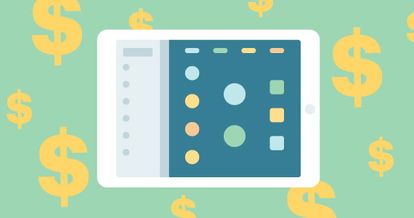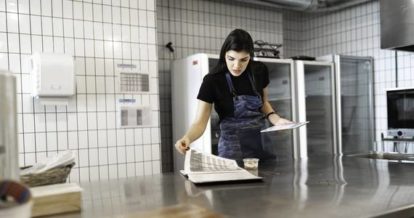Knowing how to upsell in a restaurant is more important now than ever before because restaurateurs need to maximize the spend of every guest who comes through their doors or places a delivery order.
While upselling is already challenging, it’s even trickier to do while maintaining a distance from customers. You can’t hover over your staff to make sure they capitalize on every opportunity to upsell, or call out suggestions to customers while they place orders online. The good news is your restaurant point of sale (POS) system can do these things for you!
A modern POS is more than simply a way to pass orders through to the kitchen. It’s also a valuable tool that can help you increase check sizes through upselling.
In this article on how to upsell in a restaurant using your POS, you’ll learn:
- What upselling is
- 6 POS upselling techniques, including menu engineering and automated add-on upsells
Let’s get started!
What Is Upselling?
Upselling is when customers are given purchasing suggestions that encourage them to spend more. On the one hand, upselling can augment a current order. For example, you could ask a customer if they want to upgrade their medium-sized combo to a large combo for $1 extra. Alternatively, upselling can complement an order. You could ask a customer if they want to add a side or a drink to their meal.
People often confuse upselling with suggestive selling. While upselling means suggesting an upgrade or a complementary add-on, suggestive selling means encouraging guests to buy products that are different from the ones that they ordered or would typically order. Promoting specials on your menu or encouraging guests to try new entrees are examples of suggestive selling.
Because of thin profit margins, the restaurant industry has always prioritized maximizing check sizes. However, the COVID-19 pandemic has made this effort even more critical. Because of lockdowns and capacity limitations that have impacted restaurant sales foot traffic, restaurateurs have had to keep a closer eye on techniques for optimizing the sales they do get and streamlining overall operations.
Upselling is an effective way to make more money from people who are already receptive to spending at your restaurant. If you master upselling techniques, customers will feel like it’s a no brainer to increase their order size and amount.
Servers and cashiers have traditionally been responsible for upselling to customers by asking questions like, “Do you want to supersize that?” As a result, you may think that because the pandemic has decreased face-to-face interactions, upselling has become more difficult.
What if we told you that a tool you most likely already have in your restaurant’s tech stack can make upselling easier than it’s ever been?
That’s right. Your restaurant POS can do a lot of the hard work of upselling for you.
6 Tips for How to Upsell in a Restaurant Using Your POS
So how exactly can your POS facilitate upselling to help you generate more sales for your business?
Here are six POS upselling tips to maximize profits.
1. How to Upsell Food: Use Your POS to Redesign Your Menu
Let’s start with identifying your most popular dishes and highlighting their upsell opportunities.
First, review business reports found in your POS and use them to identify items on your menu that have the highest profit margins and sell well. In the world of restaurant menu design, these items are called your “stars.”
Next, identify upselling opportunities for those stars. Let’s say a burger is the most profitable, popular menu item at your restaurant. Possible upsells can include making the burger a double, adding premium toppings (bacon, anyone?), and recommending add-ons like sides.
Now you have to redesign your menu to highlight both your stars and their upselling opportunities. Start by making sure your star items are front and center on your menu (i.e. where the eyes are naturally drawn). If they’re not, it’s time to redesign your menu.
NOTE: Front and center will mean different things for different types of menus. Physical and digital menus (i.e. PDFs on your website) should have stars in The Golden Triangle (more on this below). Mobile menus (i.e. on your online ordering platform) should have stars up at the top, where the customer has to do the least amount of scrolling on their phone.

Strategic menu design has been proven to grow profits by 15%.
How can you highlight these items and use their popularity to upsell?
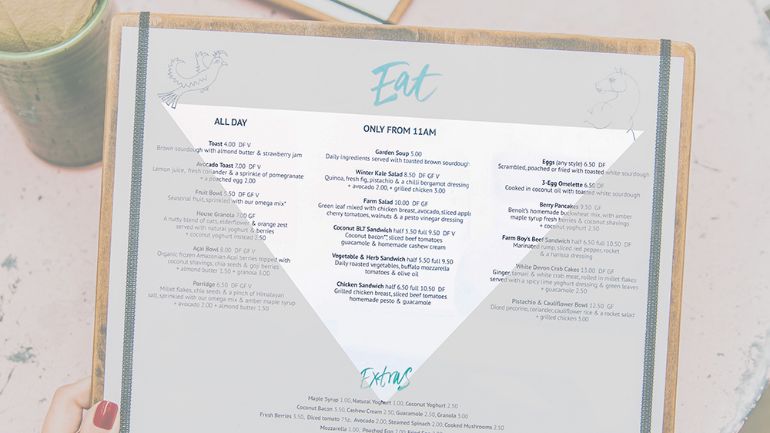
Here are some basic menu design principles that can help:
- The Golden Triangle: Place your most profitable, most popular items in a formation that mimics an equilateral triangle with the tip pointing downwards (see illustration above). Eyes naturally gravitate towards these menu items first. Make sure the upselling opportunities connected to these items (e.g. Premium burger toppings: Cheese +$1 Bacon +$2 Avocado +$3) are also within this triangle, ideally underneath or beside the star menu item.
- Visual highlights: Use elements of graphic design to make these star menu items – as well as their add-ons or combos – stand out. If you run a pizzeria, you could show off your star pizzas by placing a color block around them on your menu, and highlight premium toppings in a contrasting color.
- Color theory: Ever noticed how the most successful fast food chains use red and yellow in their branding? It’s not by accident. When it comes to food, the psychological impact of color dates back to our early ancestors. Red and yellow have been shown to increase appetite because they are associated with foods that were safe to eat. You can use pops of red and yellow on your menu to attract attention for your stars and their add-ons.
Next, dig further into your POS reports and review your restaurant metrics to also identify your “plough horses.” These menu items are popular, but not that profitable. An easy way to increase their profitability is to highlight how customers can customize these dishes with add-ons. You can use the same techniques as above – just be careful not to upstage your stars or make the menu look too busy.
And finally, make sure to update every version of your menu – print and digital – to reflect these design hacks.
2. Include Visuals in Your POS
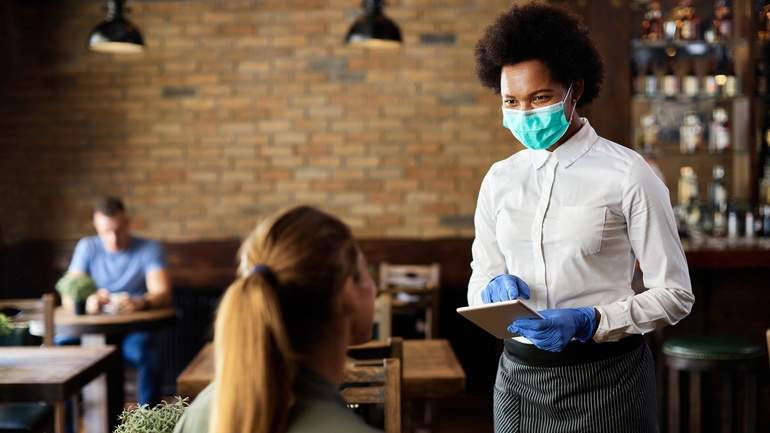
One of the best ways to maximize average check size is to show your customers appetizing photos of upgrades they can make to their meals. Your POS can do the upselling for you via customer-facing display or online ordering page.
How to use a customer-facing display to upsell with photos
Quick service restaurants typically use customer facing displays to show customers what they have ordered to reduce expensive mistakes. But this tool can be used for upselling. When you add irresistible images of upgrade options to your customer facing display, you can show customers how they can enhance their meals as you verify their orders.
Just like how retail shoppers are tempted to buy knick knacks they see in queue displays, diners are tempted to upgrade their meals when they see pictures of their options while ordering. Instead of just asking customers if they want to upgrade their side of fries to tater tots, flashing an appetizing picture of tater tots on the customer display makes the upsell that much easier.
Tips for visual upselling via your online ordering page
Add photos of premium options and upgrades to your POS-integrated online ordering system to entice customers to beef up their meals.
Let’s say you run a Thai restaurant and pad thai is your best-selling item. You notice that on-premise customers opt for premium toppings more often than your online customers do, and you assume this is because on-premise customers can see what others around them have ordered.
To solve this discrepancy, you add a photo of pad thai with prawns (your most expensive topping) as the default photo for the dish. When customers add this dish to their carts, they’re asked what topping they want. They can get veggies for the base price, or pay an additional $1 for tofu, $3 for chicken, or $5 for prawns.
Additionally, instead of just offering these premium toppings in writing, you can pair each one with a corresponding photo. However, the photo doesn’t just show the toppings, but the toppings on the actual dish (the pad thai in this case). As a result, the base price option looks less appealing than the premium seafood option customers originally saw when selecting pad thai. This strategy makes customers more likely to choose the expensive option that lured them in in the first place.
3. Create Forced Modifiers in Your POS
Remind staff to upsell with modifiers that pop up once an item is selected. For example, when a server enters a caesar salad into the POS, a modifier pops up with options for chicken, avocado, and extra bacon. This prompts the server to ask the customer what they’d like to add to their salad. This type of prompt is similar to one that would pop up when a customer orders a steak and staff is reminded to ask the customer how well they would like their steak cooked.
NOTE: Though both type of modifiers are reminders for staff – or prompts for customers who are ordering online – the first type of modifier (to add toppings to their salad) is optional, while a forced modifier (for something like how well a steak should be cooked) must be selected in order for staff to place the final order.
Set up optional modifiers for high-profit offers, add-ons, and promotions so that staff don’t forget to ask customers. You can even set up times for these upselling prompts that correspond to certain times of day. Want to squeeze more out of your lunch crowd? Try setting optional modifiers to upsell add-ons to your star menu items between the hours of 12pm and 2pm. A little reminder to both staff and customers can go a long way in boosting upsells.
4. How to Upsell Alcohol and Food: Use Your POS to Set Up Automated Reminders for Staff
Did you know that you can set up alerts on your POS for employees to see when they log in?
Why not customize this alert to remind staff to upsell food and alcohol to customers? Create different upselling promotions to prevent complacency and ensure that staff members pay attention to reminders. If they see the same text every day, they may stop noticing it.
For example, you could remind your bartenders to upsell a different premium liquor each week. One week, you could use your POS reminders to give a quick selling feature of Bombay to upsell customers who order gin or Grey Goose to customers who order vodka. Your server might say: “Did you know Grey Goose Vodka is distilled five times from winter wheat, which imparts a subtle sweetness?” A perfect way to upsell customers ordering vodka with a premium treat!
5. Run a Staff Competition and Use Your POS to Track Results
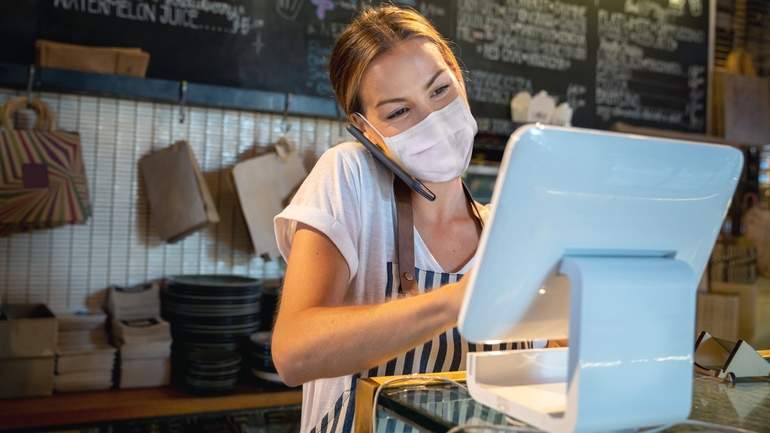
A contest is a great way to drive your staff to upsell more. A little competition can go a long way to increase the sales of add-ons. Generate customized sales reports through your POS to find out who sold the most upgrades during a given shift.
For example, kick off a busy Saturday night shift with a staff contest to see who can sell the most tater tots as a premium upgrade to fries, then check to see who won with a quick sales item total report. Don’t forget to reward the winner with a prize!
6. Start a Loyalty Program That Integrates with Your POS
Did you know that just a 5% increase in customer loyalty can lead to up to a 95% increase in profits?
While an increase in customer loyalty is always a good thing, it’s even more important in the wake of COVID-19, when restaurant foot traffic is down and acquiring new customers is trickier than ever.
That’s where a POS-integrated restaurant loyalty program like TouchBistro Loyalty comes in. You can use a loyalty program to identify customers who have purchased specific menu items or visited your restaurant over the past month. Then send those customers automated and personalized marketing messages, inviting them to return for an elevated experience next time with your premium offerings.
For example, if you notice your loyal customers have been ordering the same basic toppings when they order a large pizza, why not remind them about your other toppings? Create an email newsletter featuring photos of your pizza with premium topping options, so that customers can visualize their next order. This personalized marketing tactic may encourage them to try something different – and more expensive – on their next visit.
The Bottom Line: Knowing How to Upsell in a Restaurant Is the Key to Long Term Business Success
The restaurant industry has been dealt a difficult card because of the coronavirus pandemic. However, maximizing sales from each customer with upselling strategies is the key to maintaining a successful business even when times are tough and capacity is limited. When you use your POS to upsell to your on- and off-premise customers, you can rest easy knowing you’re doing everything possible to maximize profits.
Looking to upgrade your POS system? Learn more about TouchBistro.
Get the Complete Guide to Restaurant Reservations
Sign up for our free weekly TouchBistro Newsletter



